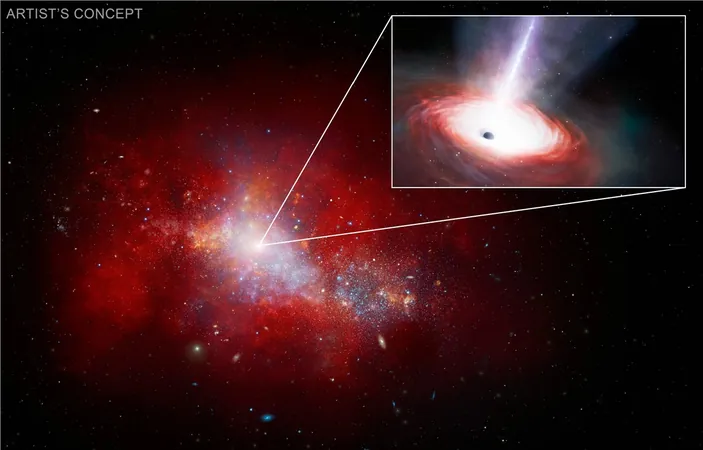
Unveiling the Mysteries of a Supermassive Black Hole Feasting in the Early Universe
2024-11-14
Author: Nur
Groundbreaking Discovery
Scientists have made a groundbreaking discovery involving a rapidly feeding black hole located at the center of a dwarf galaxy dating back to just 1.5 billion years after the big bang. This observation, captured by NASA's highly advanced James Webb Space Telescope and the Chandra X-ray Observatory, may shed light on the enigmatic growth of supermassive black holes—those colossal entities that reside at the cores of most galaxies.
The Phenomenon of LID-568
Dubbed LID-568, this remarkable black hole is consuming material at a staggering rate—over 40 times faster than what was previously thought to be theoretically possible. This extreme feeding frenzy raises crucial questions about how supermassive black holes managed to attain such vast sizes in the early universe. Despite its short-lived nature, the phenomenon around LID-568 provides a treasure trove of information that could help astronomers understand the dynamics of black hole growth during the universe's formative years.
Investigating Black Hole Growth
Historically, researchers have grappled with the conundrum of rapid black hole growth. The discovery of LID-568—hidden among thousands of objects in the COSMOS legacy survey conducted by Chandra—offers a fresh perspective. This survey involved almost 4.6 million seconds of observation time, revealing galaxies that emit bright X-ray light, yet remain elusive in optical and near-infrared wavelengths. The subsequent investigation using Webb’s unique infrared capabilities allowed astronomers to detect the faint emissions associated with LID-568, marking a significant leap in our understanding of black hole evolution.
The Eddington Limit
Skyrocketing outflows from LID-568 hinted that much of its mass may have been accrued in a singular, explosive feeding event. This black hole’s feeding rate far exceeds the Eddington limit—a crucial threshold delineating the balance between gravitational attraction and radiation pressure, which was long considered a ceiling for matter absorption.
Challenging Established Theories
The insights gained from LID-568 challenge established theories regarding the formation of supermassive black holes from smaller progenitor "seeds." These seeds could arise from the remnants of the universe’s first stars (light seeds) or through the collapse of vast gas clouds (heavy seeds). The clear implication from this discovery is that “a significant portion of mass growth can occur during a single episode of rapid feeding, regardless of the origin,” according to lead researcher Hyewon Suh from the International Gemini Observatory/NSF NOIRLab.
Implications for Cosmic Evolution
Offering tantalizing glimpses into the universe's past, this research not only enriches our knowledge of LID-568 but also fuels the ongoing exploration of how supermassive black holes developed so swiftly in the cosmic timeline. These findings, published in the esteemed journal *Nature Astronomy*, mark an exciting chapter in our quest to unravel the complexities of the universe, leaving astronomers and enthusiasts alike eager for what discoveries lie ahead in the cosmos.


 Brasil (PT)
Brasil (PT)
 Canada (EN)
Canada (EN)
 Chile (ES)
Chile (ES)
 España (ES)
España (ES)
 France (FR)
France (FR)
 Hong Kong (EN)
Hong Kong (EN)
 Italia (IT)
Italia (IT)
 日本 (JA)
日本 (JA)
 Magyarország (HU)
Magyarország (HU)
 Norge (NO)
Norge (NO)
 Polska (PL)
Polska (PL)
 Schweiz (DE)
Schweiz (DE)
 Singapore (EN)
Singapore (EN)
 Sverige (SV)
Sverige (SV)
 Suomi (FI)
Suomi (FI)
 Türkiye (TR)
Türkiye (TR)